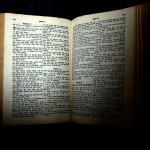The Articles of Faith, as is well-known, were orginally penned by Joseph Smith in the Wentworth letter outlining some of the distinctive teachings of this new religious movement. These brief statements would later be modified, and eventually take on canonical status as a part of the Pearl of Great Price. We teach our children to memorize them. We pass them out on pass along cards. We exegete them for specific wording on matters that remain important today, such as the authoritative nature of the LDS canon. Yet, I believe these texts ultimately fail to explain Mormonism. There are (at least) two reasons.
First, these texts represent the particular concerns at a particular moment of a particular person. The historical context in which they were produced tells us a great deal about what Joseph Smith saw as worth mentioning in 1842, but hardly represent a comprehensive, measured, or even accurate explanation of what Mormonism is all about. In fact, I will argue, the genre of explaining Mormonism often seems hampered by the AoF than illuminated by them. Second, Mormon beliefs and practices have actually changed quite a bit and only vaguely resemble many of the AoF.
On the matter of the historical moment in which the AoF were produced, the documents weighs in on some of the important matters of the day, such as how salvation can occur, the unity of the trinity, church organization, etc. It also addresses some of the other things that Smith considered important to explain, such as the relationship to civil authority, the centrality of revelation, and the general goodness of Mormon pursuits. While the pressing issues of 19th c. Christianity were around things like how churches should be organized, original sin, etc, these are someone antiquarian questions for today. They drove many of the theological movements and denominational breakups at the time they were written, but these issues rarely are the concerns weighing on the minds of investigators today. With some exceptions, outlining what the “first principles of the gospel” are is not really a live conversation among Christians, or really even Mormons, today.
But more importantly, the changes that have occurred in Mormonism make many of these Articles obsolete, incomplete, or just odd. Consider:
AoF 6: “We believe in the same organization that existed in the Primitive Church, namely, apostles, prophets, pastors, teachers, evangelists, and so forth.”
The organization of the church as we know it today was consolidated under Brigham Young, when the apostles rose to the ranks of the most authoritative body in the church, beating out several competing organizations. Furthermore, a look at this list by a contemporary mormon is extremely confusing. First, the order or the offices seems somewhat arbitrary. Second, we have no office for “pastor,” or “evangelist,” which are separate offices from “bishop” and “patriarch,” no matter what they tell you. Third, the absence of key figures such as Seventy, elder, high priest, deacon, RS president, counselor, etc suggests that our ecclesiology is not represented in this brief statement in the least.
AoF 8: We believe the Bible to be the word of God as far as it is translated correctly; we also believe the Book of Mormon to be the word of God.
Last I checked, we also believe the D&C and PoGP to be the word of God.
AoF 10: We believe in the literal gathering of Israel and in the restoration of the Ten Tribes; that Zion (the New Jerusalem) will be built upon the American continent; that Christ will reign personally upon the earth; and, that the earth will be renewed and receive its paradisiacal glory.
This is one of those ones that there is no doubt was once fervently believed in the church, but now I would say is open to question. In any case, the emphasis on this is way, way down. When was the last time you heard a talk in GC on this teaching? How many members would put this in even the top 100 most important things that we teach or believe today? How many apologetic articles have been produced defending this particular teaching? The answer to these questions: very few, if any in the last several decades.
There are other more minor examples of places where the AoF fail to accurate capture the Mormonism of the 20th c., not to mention other teachings which we constantly emphasis today that are completely absent, such as the centrality of the family. But it is the missionary discussions, the Gospel Principles manual, and the new mormon.org that most clearly illustrate the shortcomings of the AoF as they presently stand to offer a meaningful or accurate presentation of what Mormonism is all about.











